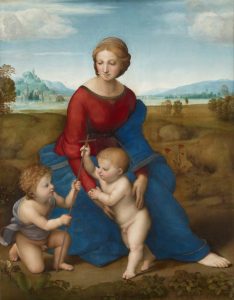Raphael, Madonna of the Meadow
Raphael spent the four years from 1504 to 1508 in Florence. There, still in his early 20s, he discovered that the painting style he had learned so painstakingly from Perugino was already outmoded. Florentine crowds flocked to the church of Santissima Annunziata to see Leonardo’s recently unveiled cartoon of the Virgin, Christ Child, Saint Anne, and Saint John. Under Leonardo’s influence, Raphael began to modify the Madonna compositions he had employed in Umbria.

In Madonna of the Meadow, Raphael adopted Leonardo’s pyramidal composition and modeling of faces and figures in subtle chiaroscuro. Yet the Umbrian artist placed the large, substantial figures in a Peruginesque landscape, with his former master’s typical feathery trees in the middle ground. Although Raphael experimented with Leonardo’s dusky modeling, he tended to return to Perugino’s lighter tonalities and blue skies. Raphael preferred clarity to obscurity, not fascinated, as Leonardo was, with mystery. Raphael quickly achieved fame for his Madonnas, which depict Mary as a beautiful young mother tenderly interacting with her young son. In Madonna of the Meadow, Mary almost wistfully watches Jesus play with John the Baptist’s cross-shaped staff, as if she has a premonition of how her son will die.[1]
- Fred S. Kleiner, Gardner’s Art Through the Ages: The Western Perspective, vol. 2, 15th ed., (Boston: Cengage Learning, 2017), 510. ↵

